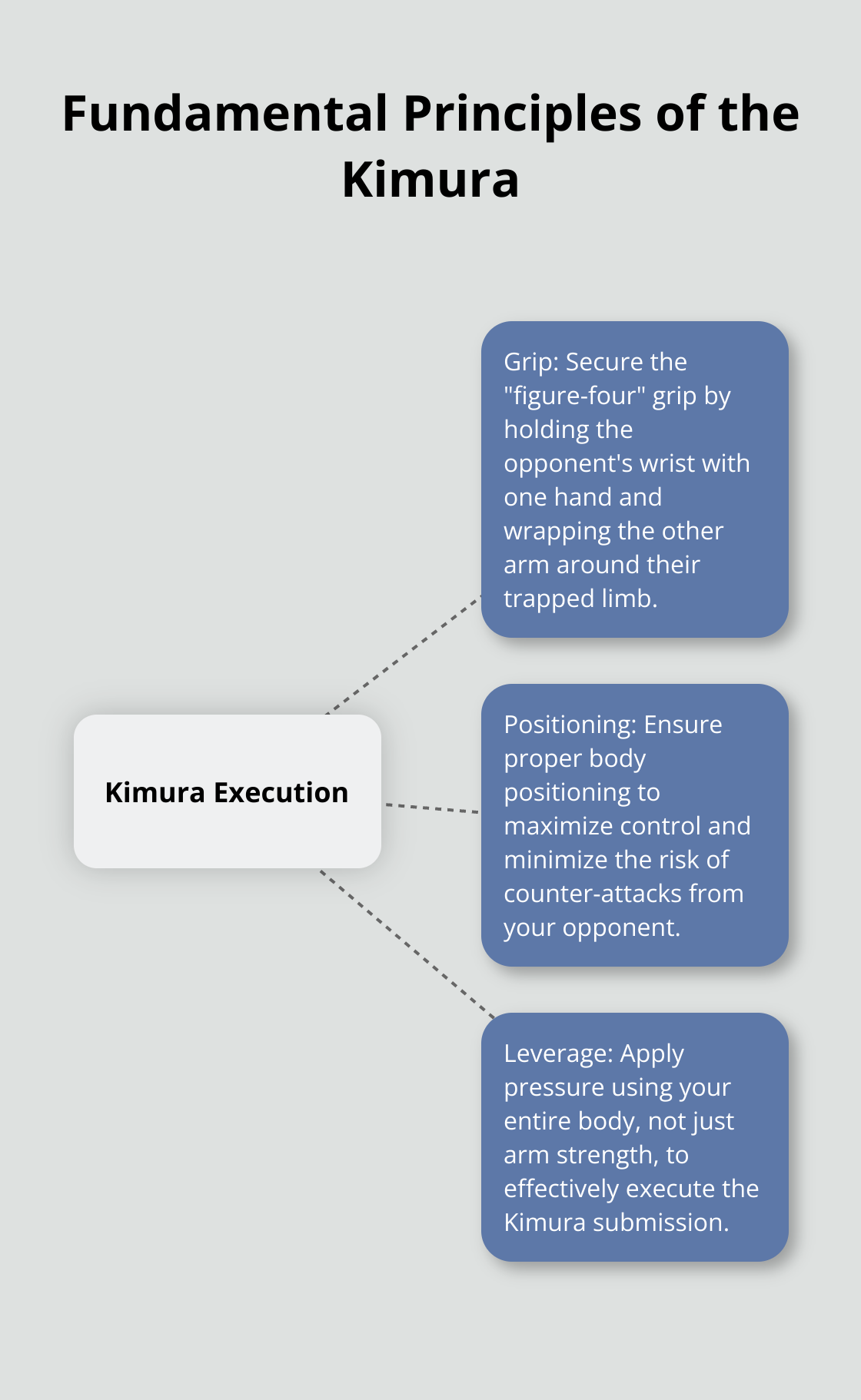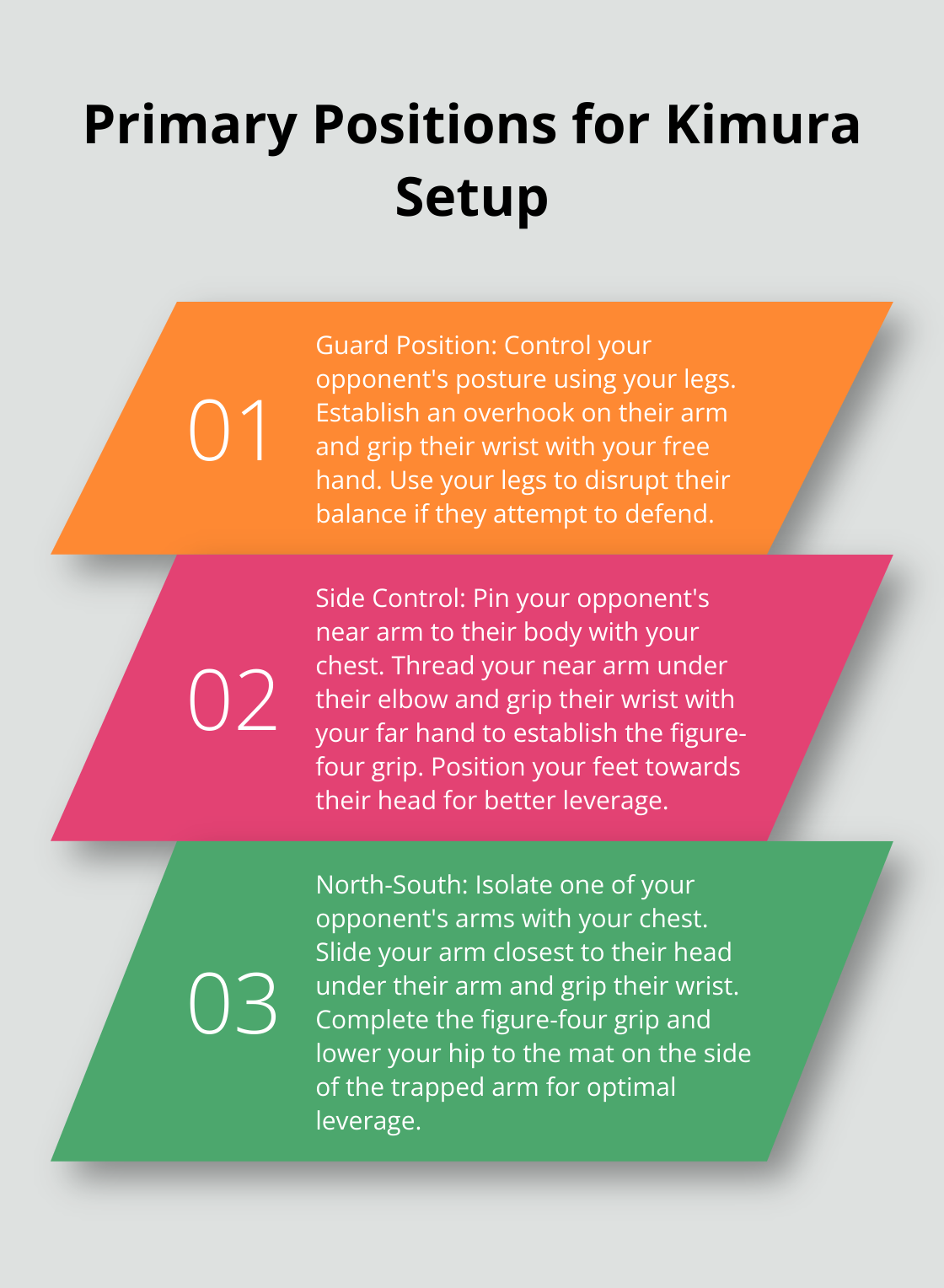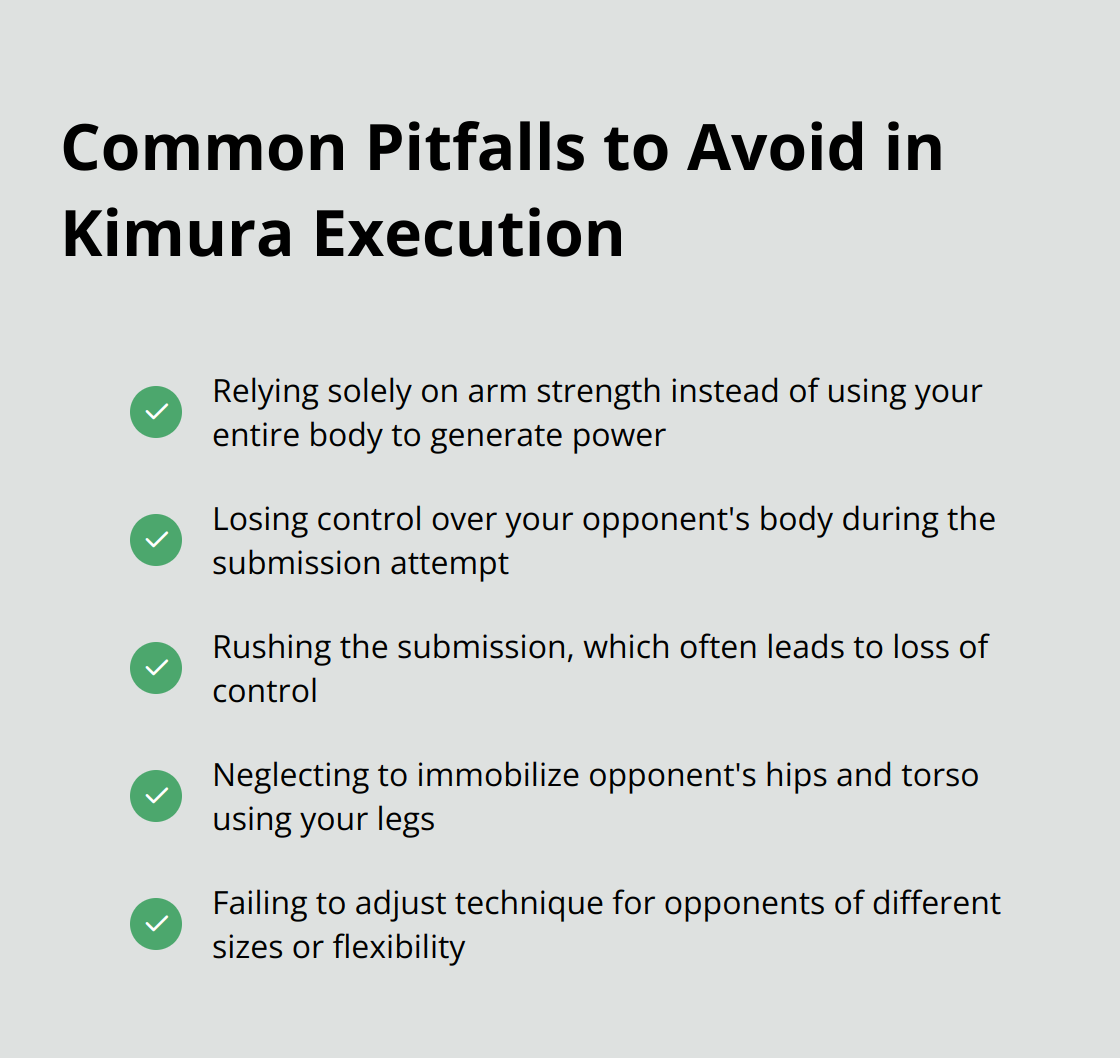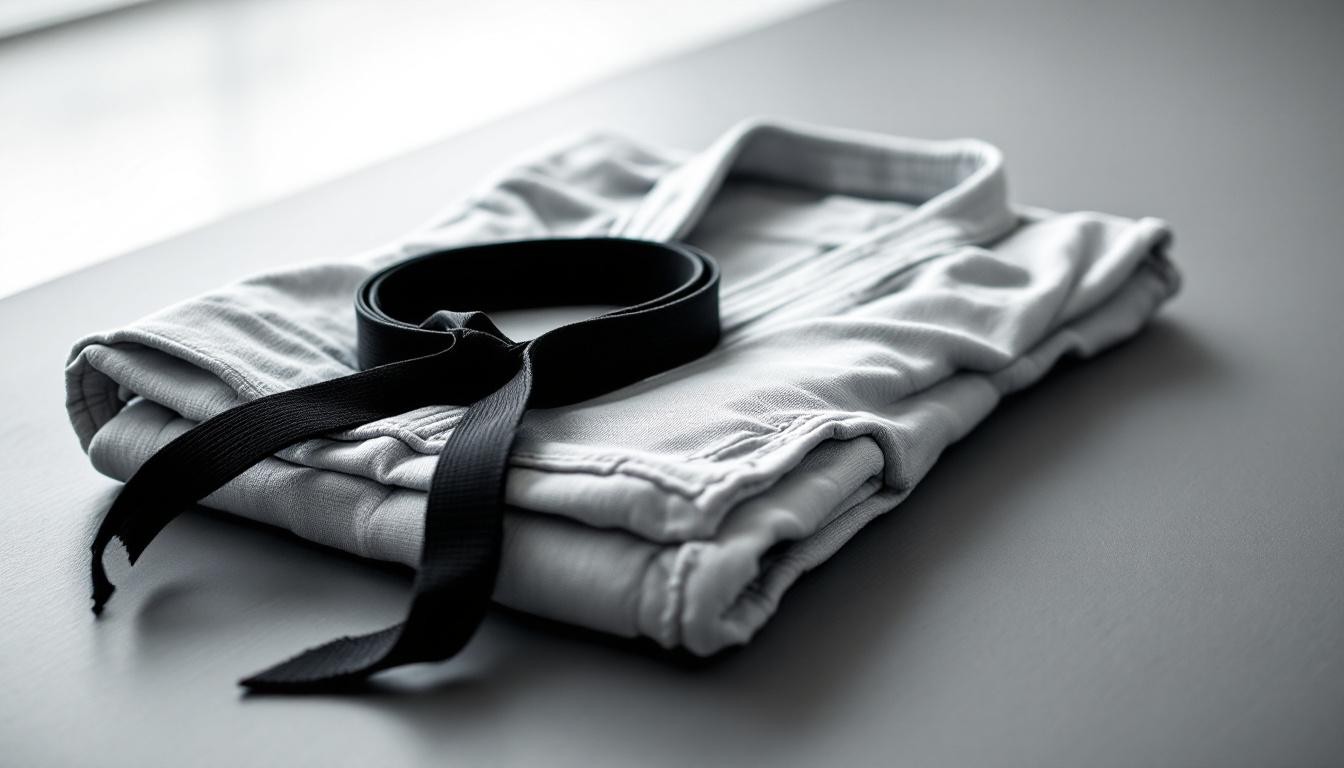At Jiu Jitsu, we’re excited to share our expertise on one of the most powerful submissions in grappling: the Kimura lock.
This technique, closely related to the Americana in Jiu Jitsu, is a game-changer when executed correctly. In this post, we’ll break down the key elements of the Kimura, from its history to proper execution.
Get ready to elevate your submission game and add a formidable weapon to your arsenal.
What Is the Kimura Lock?
Origins and Historical Significance
The Kimura lock, a potent submission technique in Brazilian Jiu-Jitsu and mixed martial arts, traces its roots to the early 20th century. This technique bears the name of Masahiko Kimura, a legendary Japanese judoka who famously used it to defeat Hélio Gracie in 1951, catapulting it to worldwide recognition. As a tribute to Kimura’s victory, the gyaku-ude-garami he used to defeat Gracie was renamed as “Kimuriana” by sports writers shortly after his second tour.
Biomechanics of the Kimura
The Kimura targets the shoulder joint, specifically the rotator cuff muscles and the glenohumeral joint. This submission works through external rotation of the shoulder beyond its normal range of motion, which places immense stress on the joint and surrounding tissues. The Kimura’s effectiveness stems from its ability to control the opponent’s arm and shoulder, thus limiting their escape options.
Fundamental Principles
To execute a successful Kimura, practitioners must focus on three key principles:
- Grip: The “figure-four” grip involves securing the opponent’s wrist with one hand and wrapping the other arm around their trapped limb.
- Positioning: Proper body positioning maximizes control and minimizes the risk of counter-attacks.
- Leverage: The application of pressure uses the entire body, not just arm strength.

Versatility in Application
The Kimura’s strength lies in its adaptability. Practitioners can apply it from various positions (guard, side control, and even standing), making it a valuable tool in both grappling and MMA contexts.
Training Approach at Souza Grappling Co.
At Souza Grappling Co., we emphasize understanding the biomechanics behind submissions like the Kimura. Our expert trainers guide students through proper execution, ensuring they grasp not only the physical movements but also the underlying principles. This comprehensive approach helps practitioners develop a deeper understanding of the technique, leading to more effective application in both training and competition scenarios.
As we move forward, we’ll explore the various setups for the Kimura lock, providing you with the tools to incorporate this powerful submission into your grappling arsenal.
Setting Up the Kimura
Starting Positions
The Kimura lock offers versatility in its application. We teach our students to initiate this submission from three primary positions: guard, side control, and north-south. Each position presents unique advantages and challenges.

Guard Position Setup
Control is paramount when setting up the Kimura from guard. Begin with an overhook on your opponent’s arm. Use your legs to control their posture and prevent them from rising. Grip their wrist with your free hand, but stay alert to their other arm. They might attempt to defend by clasping their hands together. To counter, use your legs to disrupt their balance, creating an opportunity to break their grip.
Side Control Dominance
Side control provides a dominant position for the Kimura. Isolate your opponent’s near arm by pinning it to their body with your chest. Thread your near arm under their elbow and grip their wrist with your far hand to establish the figure-four grip. To enhance leverage, position your feet towards their head, creating a perpendicular angle with their body.
North-South Precision
The north-south position offers excellent control for the Kimura. Isolate one of your opponent’s arms with your chest. Slide your arm closest to their head under their arm and grip their wrist. Complete the figure-four grip by placing your other arm over theirs. For optimal leverage, lower your hip to the mat on the side of the trapped arm, creating a fulcrum for the submission.
Gripping Techniques
Proper gripping technique forms the foundation of a strong Kimura. The figure-four grip allows for maximum control and torque on the shoulder joint. Unlike the top wristlock, for Kimura, grab the opponent’s hand with your hand that is on the same side and position the opposite arm behind the opponent’s arm.
Body Positioning for Leverage
Body positioning plays a vital role in executing an effective Kimura. Try to create a 90-degree angle between your body and your opponent’s arm. This angle maximizes leverage and minimizes their ability to resist. Keep your elbows close to your body to maintain control and generate power from your core (not just your arms).
At Souza Grappling Co., we emphasize regular drilling of these setups. Our expert trainers guide students through each position, ensuring proper technique and body mechanics. Mastering these setups will equip you with the skills to apply the Kimura effectively in various grappling scenarios. Now, let’s move on to the execution of this powerful submission.
Mastering the Kimura Execution
Precision in Technique
The Kimura submission works by isolating the elbow and shoulder joints through the use of a figure-four grip. Create a perpendicular angle with your opponent’s body after securing the grip. This position enhances leverage and control. Lift their elbow off the mat while pinning their wrist to their lower back. Apply pressure to the shoulder joint by rotating their arm past their spine. Drive your chest down to maintain pressure on their shoulder throughout the movement.
Common Pitfalls to Avoid
Many practitioners rely solely on arm strength, which is a mistake. Use your entire body to generate power instead. Another frequent error is the loss of control over your opponent’s body. Combat this by using your legs to immobilize their hips and torso. Rushing the submission often leads to loss of control. Take your time, maintain position, and increase pressure gradually for optimal results.

Adapting to Various Scenarios
Flexibility in application is essential. For larger opponents, control their body before attempting the submission. Against more flexible practitioners, adjust your grip higher up their arm for increased leverage. When facing strong resistance, consider transitioning to other submissions or sweeps that complement the Kimura (such as the armbar or back take).
Body Mechanics and Leverage
Proper body mechanics play a crucial role in executing an effective Kimura. Try to use your entire body as a unit, not just your arms. Keep your elbows close to your body to maintain control and generate power from your core. This approach will help you overcome stronger opponents and reduce the risk of injury.
Training and Practice
Regular drilling is key to mastering the Kimura. Practice the technique from various positions (guard, side control, north-south) to develop a well-rounded understanding of its applications. Incorporate the Kimura into your sparring sessions to test its effectiveness against resisting opponents. This real-world practice will help you refine your technique and develop the necessary timing and feel for successful execution.
Final Thoughts
The Kimura lock stands as a cornerstone technique in Brazilian Jiu-Jitsu and MMA, offering practitioners a powerful tool for submission and control. From its origins with Masahiko Kimura to its modern applications, the Kimura has proven its effectiveness across various grappling scenarios. Mastering the Kimura requires dedication, practice, and a deep understanding of body mechanics.
We emphasize the importance of proper grip, positioning, and leverage in executing this submission successfully. The key lies not in brute strength, but in precise technique and full-body engagement. Consistent drilling and practice are essential for developing the muscle memory and instincts necessary for seamless execution during live sparring and competition.
At Souza Grappling Co., we help you refine your grappling skills, including mastery of techniques like the Kimura and Americana in Jiu-Jitsu. Our expert instructors provide personalized guidance in a supportive environment, ensuring you develop proper form and technique. You can add a powerful submission to your arsenal and enhance your overall grappling game through dedicated practice of the Kimura.




